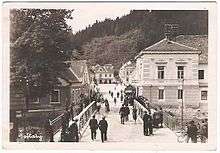Šoštanj
| Šoštanj | |
|---|---|
 Šoštanj Location in Slovenia | |
| Coordinates: 46°22′47.16″N 15°2′53.65″E / 46.3797667°N 15.0482361°ECoordinates: 46°22′47.16″N 15°2′53.65″E / 46.3797667°N 15.0482361°E | |
| Country |
|
| Traditional region | Styria |
| Statistical region | Savinja |
| Municipality | Šoštanj |
| Area | |
| • Total | 3.7 km2 (1.4 sq mi) |
| Elevation | 358.7 m (1,176.8 ft) |
| Population (2012) | |
| • Total | 2,933 |
| Climate | Cfb |
| [1] | |
Šoštanj (pronounced [ˈʃoːʃtan]; German: Schönstein) is a town in northern Slovenia. It is the seat of the Municipality of Šoštanj. The area is part of the traditional region of Styria. The entire municipality is now included in the Savinja Statistical Region.[2]
History

Šoštanj was first mentioned in written documents dating to around 1200 as Schönstein in relation to its castle. As a market town it was first mentioned in 1348. It was given town status in 1919 and until the 1960s was the center of the Šalek Valley (Slovene: Šaleška dolina). In 1963 nearby Velenje became the administrative center. Šoštanj again became a municipal center in the late 1990s.[3] The town has a long leather-working history, with industrial-scale activity going back to 1788. The factory was owned by the Woschnagg family, a Germanized branch of the Vošnjak family, until it was nationalized in 1945.[4] The processing factory was closed down in 1999. A leather industry museum is now open in the town.[5]
Mass graves
Šoštanj is the site of four known mass graves and one unmarked grave from the period immediately after the Second World War. The Gorica 1–4 mass graves (Slovene: Grobišče Gorica 1–4) all lie north of Lake Šoštanj. The first grave is also known as the Čebul Meadow Mass Grave (Grobišče Čebulov travnik).[6] The second grave is also known as the Stvarnik Meadow Mass Grave (Grobišče na Stvarnikovi njivi) or the Bodjan Meadow Mass Grave (Grobišče na Bodjanovi njivi).[7] The four graves contain the remains of Slovene, Croatian, and German civilians that were murdered on the Gorica Ridge northeast of the town in late May 1945 as they were fleeing to Carinthia. The victims include a group of wealthy Šoštanj residents murdered on 23 May 1945.[8][9] The graves are part of the same set as the Družmirje 1 and 2 mass graves. The Janez Pirmanšek Grave (Grob Janeza Pirmanška) lies in a meadow west of the town, at Primorska Cesta no. 7, above the sawmill and log storage area. A memorial to Šoštanj residents that fell while serving in the German army formerly stood at the site. The grave contained the remains of the Slovene civilian Janez Pirmanšek, who was liquidated on 20 May 1945.[10]
Power plant
Šoštanj Power Plant begun producing electricity in 1956.[11] The plant is partly sponsored by the European Bank for Reconstruction and Development and the European Investment Bank, and is highly controversial. [12]
Church
The parish church in the town is dedicated to Michael the Archangel and belongs to the Roman Catholic Diocese of Celje. A second church in town was built in 1776 on the site of a 13th-century predecessor and is dedicated to Saints Hermagoras and Fortunatus.[13]
Notable residents
- Karel Destovnik, a.k.a. Kajuh (1922–1944), Partisan poet
- Jožef Kastelic (Castelliz) (1710–after 1773), religious writer
- Ivan Samonigg, Austrian officer and military education reformer (1839–1915)
- Mihael Valenci (1728–1813), technical writer and physician
- Josip Vošnjak (1834–1911), 19th-century national liberal leader
- Mihael Vošnjak (1837–1920), engineer and politician
References
- ↑ Statistical Office of the Republic of Slovenia
- ↑ Šoštanj municipal site
- ↑ Šoštanj municipal site
- ↑ Krajevni leksikon Slovenije vol. 3 (Ljubljana: DZS, 1976), p. 437
- ↑ Šoštanj leather museum site
- ↑ Gorica 1 Mass Grave on Geopedia (Slovene)
- ↑ Gorica 2 Mass Grave on Geopedia (Slovene)
- ↑ Gorica 3 Mass Grave on Geopedia (Slovene)
- ↑ Gorica 4 Mass Grave on Geopedia (Slovene)
- ↑ Janez Pirmanšek Grave on Geopedia (Slovene)
- ↑ Šoštanj power station site
- ↑ Sostanj lignite thermal power plant unit 6, Slovenia (Bankwatch)
- ↑ Slovenian Ministry of Culture register of national heritage reference number ešd 3436
External links
| Wikimedia Commons has media related to Šoštanj. |
